Growth Strategy Matrix
A Builder’s Guide to Positioning Your Product
Hey, I’m Marco 👋
One person. One laptop. Building digital products in public on the road to €1M.
This post is part of Superbuilders, a series from One Million Goal where I share the tools, strategies, and lessons that help indie builders move faster and think bigger.
Every product lives in a market… even when its founder pretends it doesn’t.
And the market, at its core, only asks two questions:
Are you better?
Are you cheaper?
Everything else is noise.
Everything else is storytelling.
For solopreneurs like us, this is even more true. We often build fast, ship faster, and hope that traction will magically follow. But no matter how much we hustle, how many nights we spend tweaking the UI, or how many features we stack on top of each other, one thing is certain:
If you don’t know where your product sits on the map, you’re building blind.
That’s why I want to revisit one of the simplest, yet most powerful, frameworks for understanding how products grow: the Growth Strategy Matrix, created by Tony Ulwick.
This matrix helps you answer a fundamental question:
Given the job your customers are trying to get done, and the cost they’re currently paying to get it done, which strategy gives your product the highest chance of success?
Before we dive in, a quick note.
A while ago I wrote an article about Jobs To Be Done, the idea that people don’t buy products, they “hire” products to help them make progress. If you want a refresher, you can read it here → Observe.
For now, let’s jump straight into the matrix.
What the Growth Strategy Matrix Really Shows
The Growth Strategy Matrix is built on two variables:
How well a product helps customers complete their Job To Be Done (better or worse).
How much it costs compared to current solutions (more expensive or cheaper).
From these, four quadrants (plus a “limbo”) emerge:
Better & More Expensive
Better & Cheaper
Worse & Cheaper
Worse & More Expensive
Same price / same quality (the limbo zone)
Each of these leads to a specific strategy.
Here’s the visual layout:
The Differentiated Strategy
Better & More Expensive
This strategy targets customers who are underserved: people who are currently using a solution that doesn’t fully meet their needs. They want something better, and they’re willing to pay more.
Typical pattern:
Enter a market dominated by established companies
Deliver something dramatically superior
Charge a premium
Capture profit rather than market share
Think of:
Nespresso: premium coffee experience
Nest: a thermostat seven times more expensive than the market average
Dyson: vacuum cleaners priced like luxury goods
Tesla: early Roadster days, ultra-premium EV
Nest is one of the clearest examples.
They entered a boring, saturated market… and blew it open by making a thermostat intelligent, beautiful, and desirable. Their product was €250 when the market averaged €35, but they owned around 25% of profits with less than 10% of the market.
Differentiation is profitable, but it’s hard.
You must:
deliver true, perceived superiority
find a niche that deeply cares
justify a high price
👉 For solopreneurs?
This quadrant is possible, but demanding. It works if:
- you’re serving a high-value niche
- your users have urgent unmet needs
- you can deliver 10x performance through design or tech
But in most cases, solo builders don’t start here.The Dominant Strategy
Better & Cheaper
This is the holy grail.
You outperform the competition and cost less. When this happens, the old guard usually can’t defend itself.
Netflix vs Blockbuster
Uber vs taxis
Google Search vs everything before it
Shopify vs custom-built ecommerce platforms
Netflix is the perfect example. Before streaming:
you rented DVDs,
paid per movie,
or subscribed to expensive cable bundles.
Then suddenly: unlimited content → €7.99/month and way more convenience.
Data suggests that to win with a dominant strategy, a product must:
improve customer outcomes by at least 20%
reduce price by at least 20%
This is brutal for established companies: they can’t drop prices without destroying their margins.
👉 For solopreneurs?
This strategy is appealing… but also the hardest. Competing as “better & cheaper” usually requires:
- serious automation
- economies of scale
- strong brand trust
- or infrastructure-level innovation
Still, it’s the dream quadrant. When companies get here, they win markets.The Disruptive Strategy
Worse & Cheaper
This strategy targets:
overserved customers: people using overkill solutions
nonconsumers: people priced out of the market completely
This is where many startups originate.
You build something that helps people do the job, even if it’s not as powerful — because they don’t need all the power.
Examples:
Canva vs Photoshop
Google Docs vs Microsoft Word
Duolingo vs expensive language schools
Coursera vs universities
Fiscozen (Italy) vs traditional accountants
If you compare Canva to Photoshop, Canva loses. Badly. But Canva wasn’t trying to win that fight.
It targeted:
people who needed simple graphics
people who found Photoshop overwhelming
people who couldn’t afford Adobe’s pricing
And it grew into a giant.
There’s also a process here:
Start at the bottom → serve simple use cases → improve over time → eventually threaten the established companies.
This is Clayton Christensen’s classic “disruption curve”.
👉 For solopreneurs?
This is the most accessible quadrant.You don’t need to beat the market — you need to serve people who are currently ignored.
This is where most indie hackers win.The Discrete Strategy
Worse & More Expensive
This sounds insane, but it happens whenever the customer is trapped, when alternatives are limited or unavailable.
Examples:
Motorway service station (in Italy are called Autogrill)
Airport shops
Stadium bars
ATMs in remote areas
You pay €4 for a bottle of water not because it’s good, but because you have no choice.
This is not where you want to build your product… unless you’re in a genuinely constrained market (rare for SaaS).
👉 For solopreneurs?
Avoid this entirely. Your users always have alternatives. Always.The Sustaining Strategy
Slightly better or slightly cheaper
This is the middle zone, the limbo.
Your product is similar to existing solutions, maybe 5% better or cheaper.
This strategy:
works for established companies
kills new entrants
Why? Because customers rarely switch for tiny improvements. Changing tools costs more, emotionally and practically, than the 5% gain you’re offering.
👉 For solopreneurs?
If you’re launching something new: Avoid sustaining improvements. No one will care.
If you’re an established player, it helps you maintain position… but it’s not a growth engine.How to Actually Use the Matrix
You can’t choose a strategy without understanding your customers’ JTBD and whether they’re:
underserved → want much better, willing to pay
overserved → want simpler and cheaper
nonconsumers → can’t afford the current solution
stuck → can’t switch easily
satisfied → don’t want change
Some examples:
If customers are overserved, a Differentiated Strategy will fail: you’ll build something more complex and expensive for people who actually want the opposite.
If customers are underserved, a Disruptive Strategy will fail: no one wants “worse and cheaper” when they are begging for “better”.
Everything depends on what progress they want to make.
Putting the Strategies Into Motion
Differentiated Strategy: When to Use It
Works when:
customers are extremely underserved
you can deliver a truly superior solution
you can justify a premium price
Apple used it with the first iPhone. The industry laughed (“$500 for a phone???” - Steve Ballmer)… but the device was radically better.
Once Apple scaled, they moved toward the dominant quadrant with products like the iPhone SE.
Differentiation → then expansion.
Disruptive Strategy: When to Use It
Perfect when:
the market is over-engineered
customers are overwhelmed
pricing excludes many people
The disruption process:
Enter with something simple, inferior, cheap
Serve ignored users
Improve the product
Move upward
Replace established companies
Most solopreneurs thrive here. It’s the most realistic path from zero.
Dominant Strategy: When to Use It
Hardest to pull off.
To win:
+20% performance
–20% price
exceptional distribution
Startups dream of this. Big players fear it. But it’s rarely the first move for a solo builder.
Discrete Strategy: When to Use It
Use only when:
the context literally blocks alternatives
switching is impossible
urgency is extreme
In software, this is nearly never the case.
Sustaining Strategy: When to Use It
Works for:
established companies defending market share
products already adopted
brands with loyal customer bases
If you’re launching a new SaaS:
Don’t build a sustaining product. No one needs a 5% improvement from a stranger.
So… Which Strategy Should Solopreneurs Choose?
Let’s end with two builders you know well: Marc Lou and Pieter Levels.
Their stories demonstrate how solopreneurs naturally fit into specific quadrants.
Marc Lou
Marc Lou is a great example of how solopreneurs naturally start in the disruptive quadrant, not by outbuilding big competitors, but by serving ignored segments with simple, fast, and emotionally resonant products.
Between 2022 and 2025, Marc built dozens of products. Many failed, but each one taught him something and helped him identify overserved or overpriced markets.
Some of his early experiments included:
Mood2Movie – viral movie recommendations based on mood
Habits Garden – a gamified habit tracker (~$500/month)
Books Calculator – a simple reading progress tool that went viral
Decision Game – a small web game to help people stop overthinking
None of these were “better than the established companies”. They were simpler, cheaper, and good enough — classic disruptive strategy.
His breakthroughs came when he doubled down on this approach:
ShipFast – a fully packaged starter kit for developers, born from his own repeated pain building infrastructure
CodeFast – an AI-powered coding course for founders who want to build SaaS in 14 days
DataFast – a real-time traffic globe that turned analytics into a game
TrustMRR, IndiePage, BioAge, ZenVoice, and more — all small but highly focused tools
Marc didn’t create the “best” design platform or the “best” analytics tool.
He created tools for people who felt the alternatives were:
too complex
too expensive
or simply not built for them
This is disruption in its purest indie-hacker form.
Pieter Levels
Pieter is the king of starting simple.
Nomad List began as a spreadsheet.
RemoteOK was a job board with a basic UI.
Levels doesn’t try to be better than giants. He tries to be faster, simpler, and accessible.
Again: Disruptive Strategy.
His playbook:
identify an underserved or ignored niche
build a focused product fast
price transparently
improve based on usage
compound over years
He never tries to win the “dominant” quadrant from day one. He enters through the side door.
The Solopreneur’s Takeaway
Most solo builders won’t start with:
Differentiated (too expensive and complex)
Dominant (too demanding in cost + performance)
Discrete (almost never applicable)
Sustaining (not attractive enough)
The realistic quadrant (the one where your unfair advantage is speed, simplicity, and focus) is:
The Disruptive Strategy
Serve people who don’t need everything.
Serve people who can’t afford the alternatives.
Serve people who are ignored.
Build fast.
Start simple.
Grow upward.
That’s the solopreneur path.




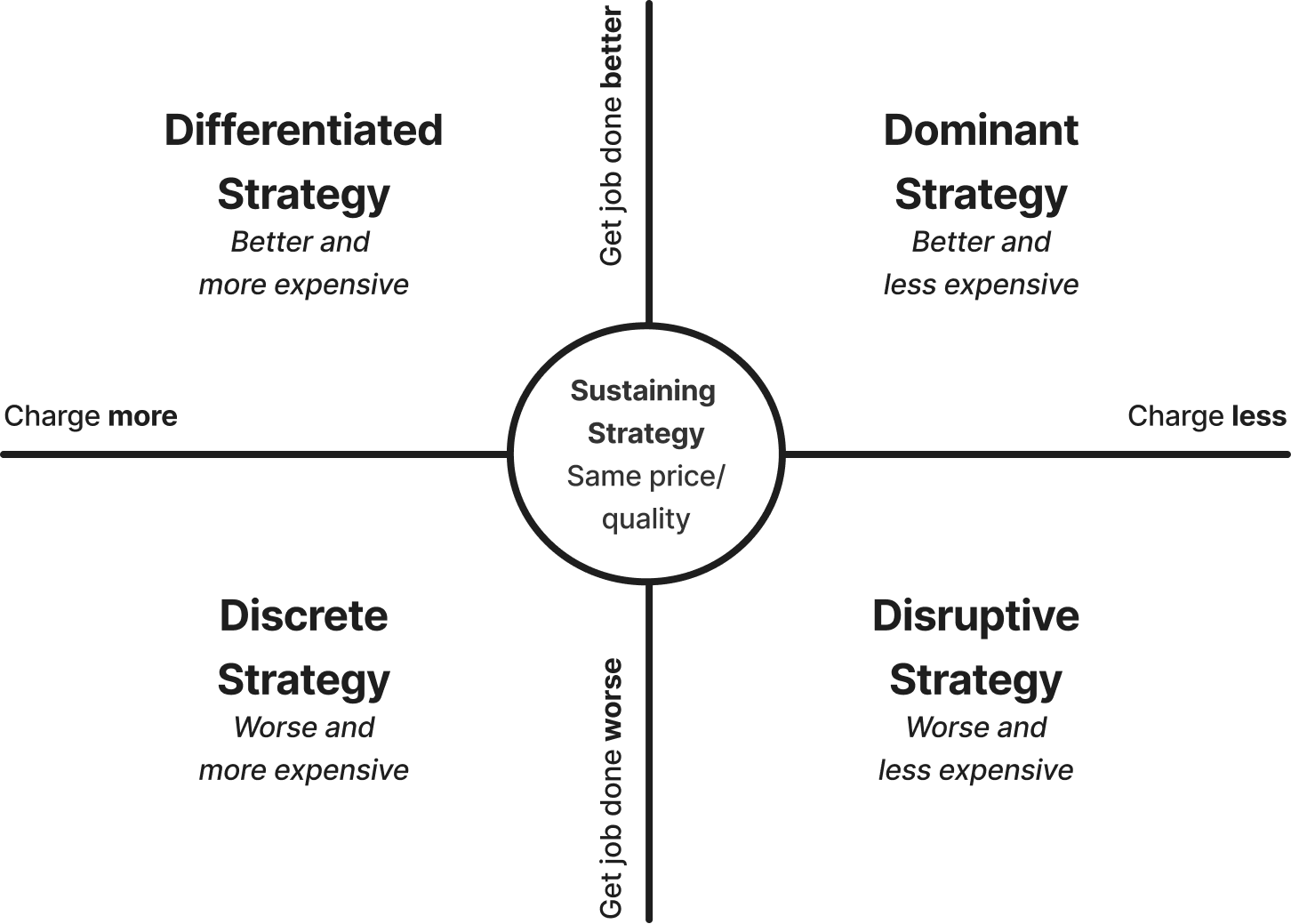

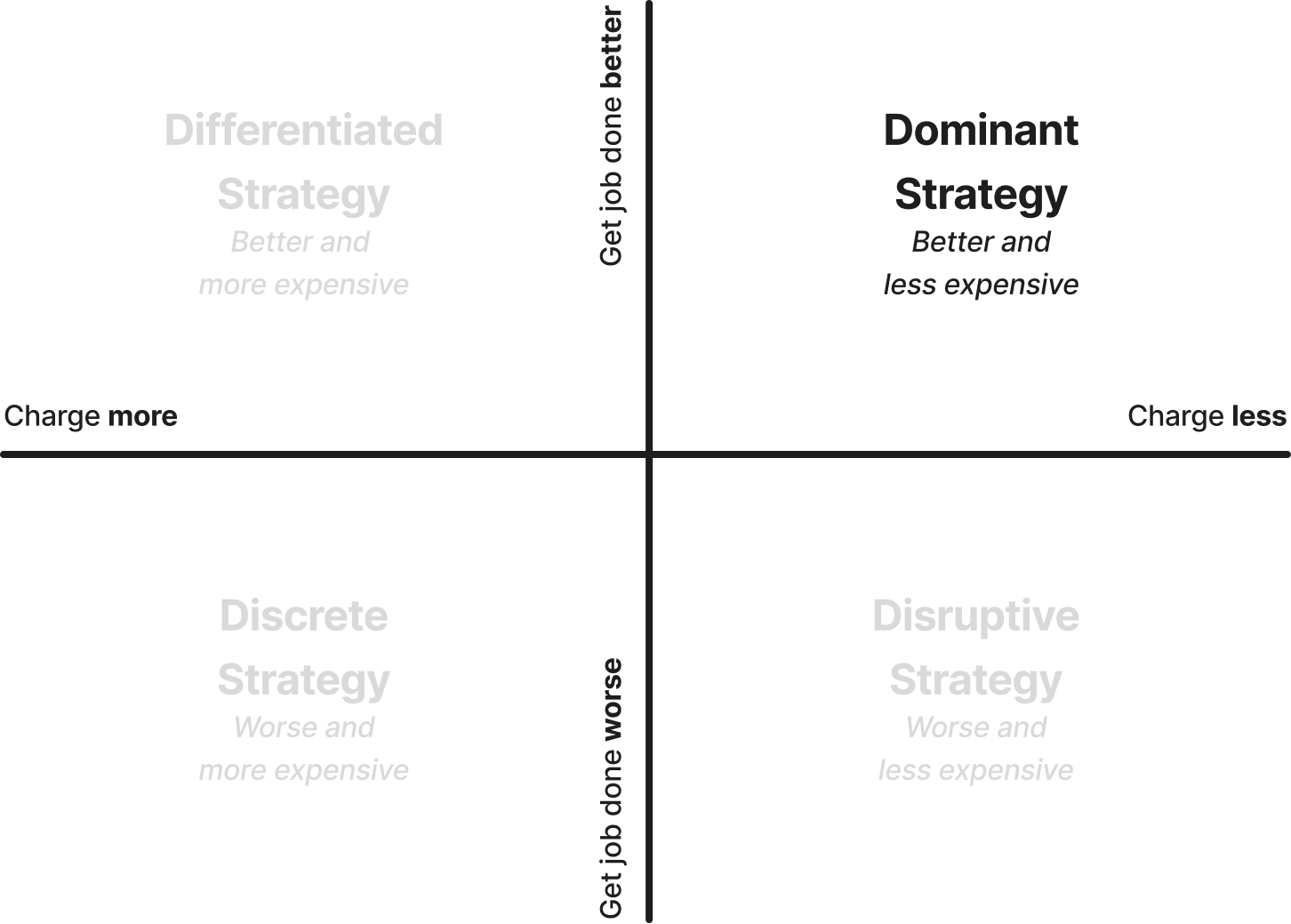
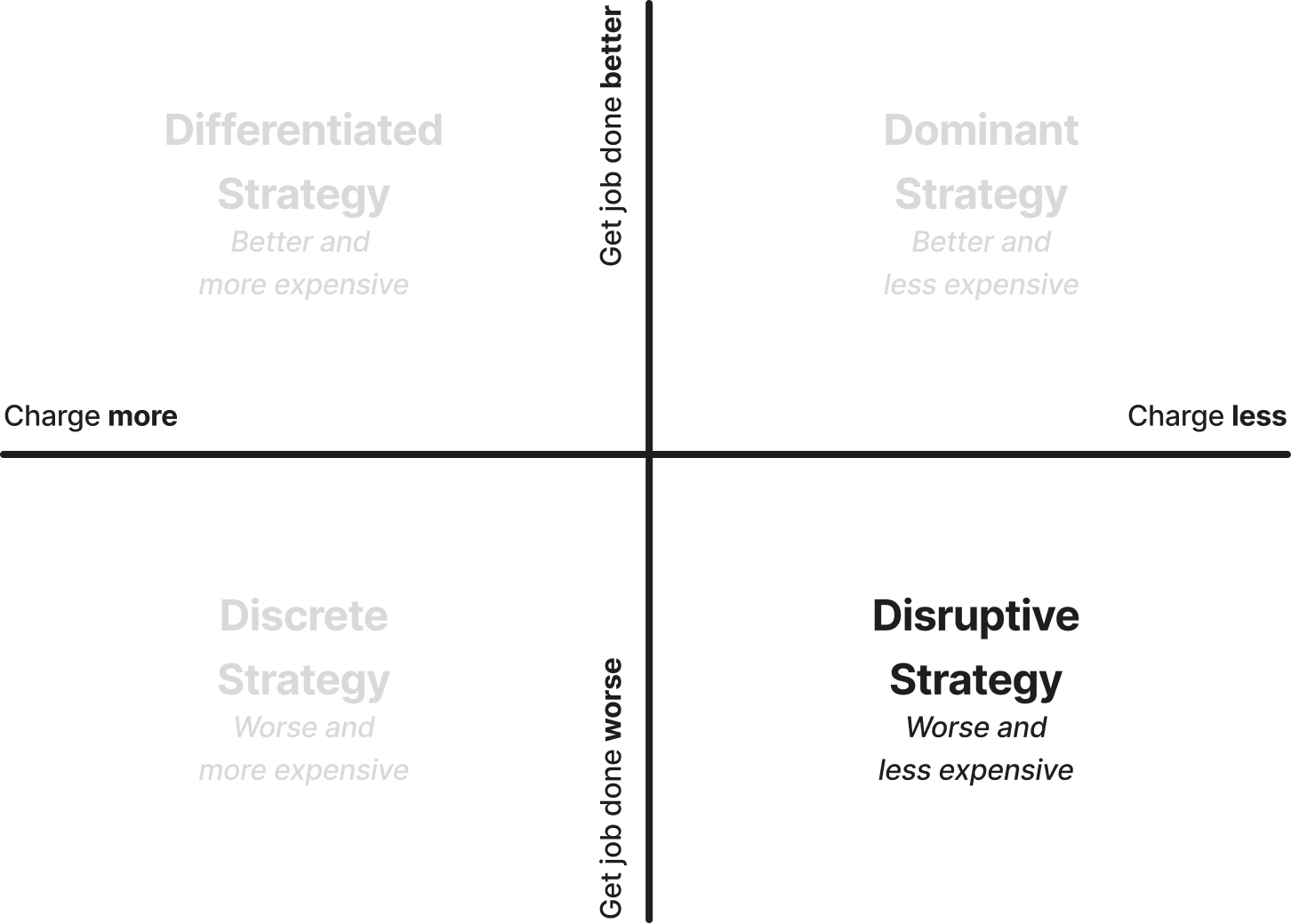
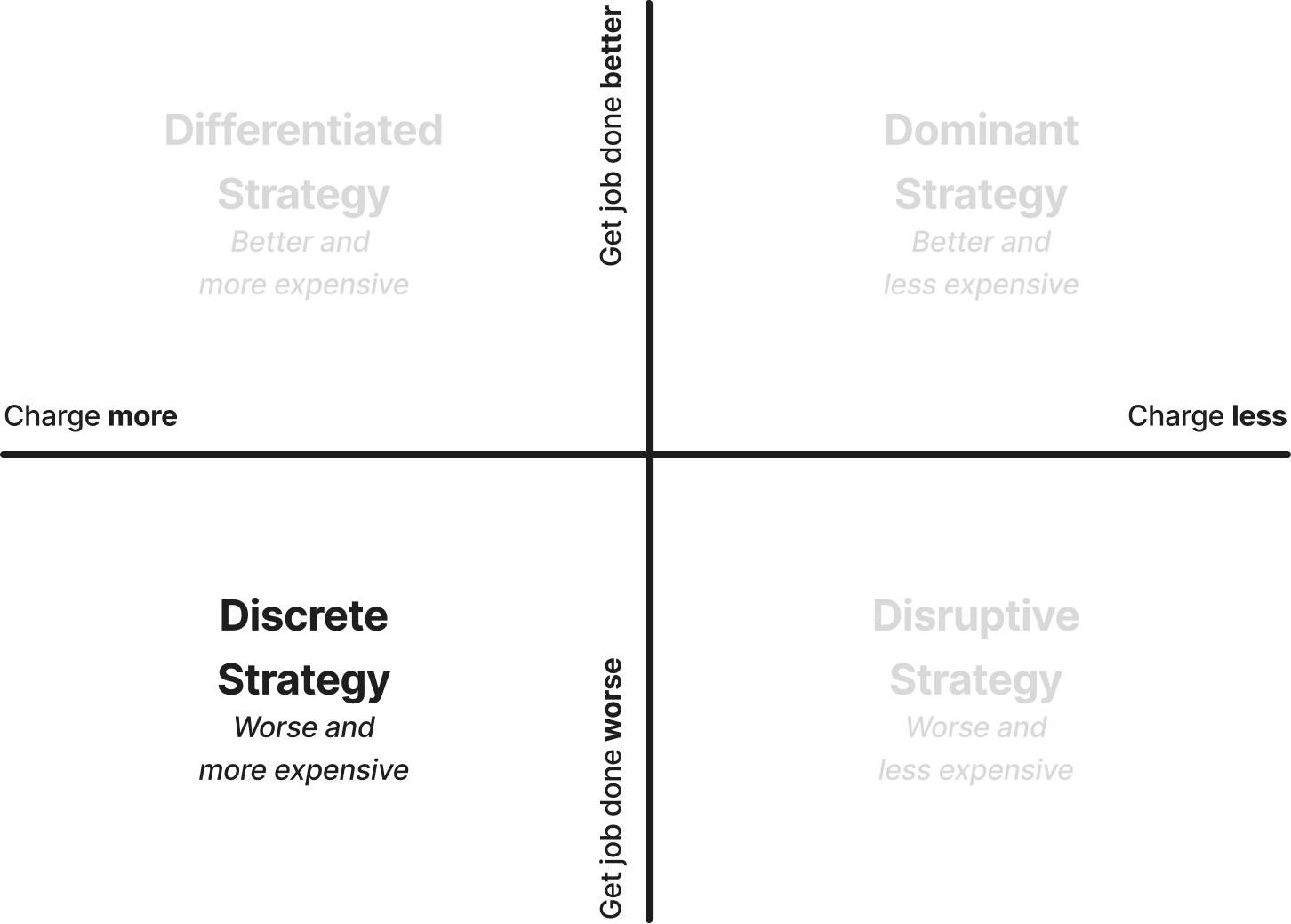
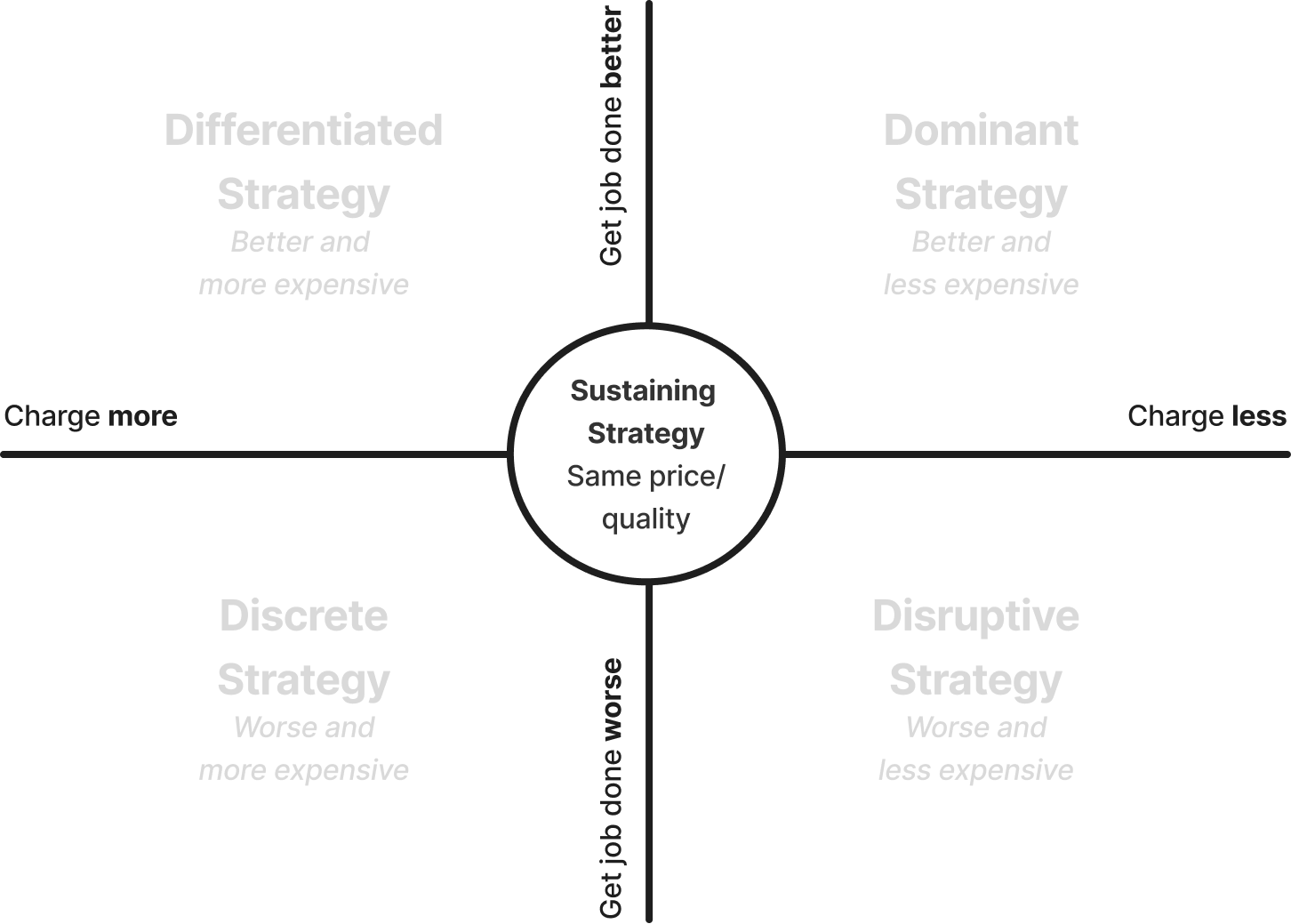
Complimenti Mark !
Utilizzerò il tuo articolo nel prossimo thread che scriverò per X
grazie sei sempre d’ispirazione !
Bell’articolo: lo userò per le lezioni all’università 😁